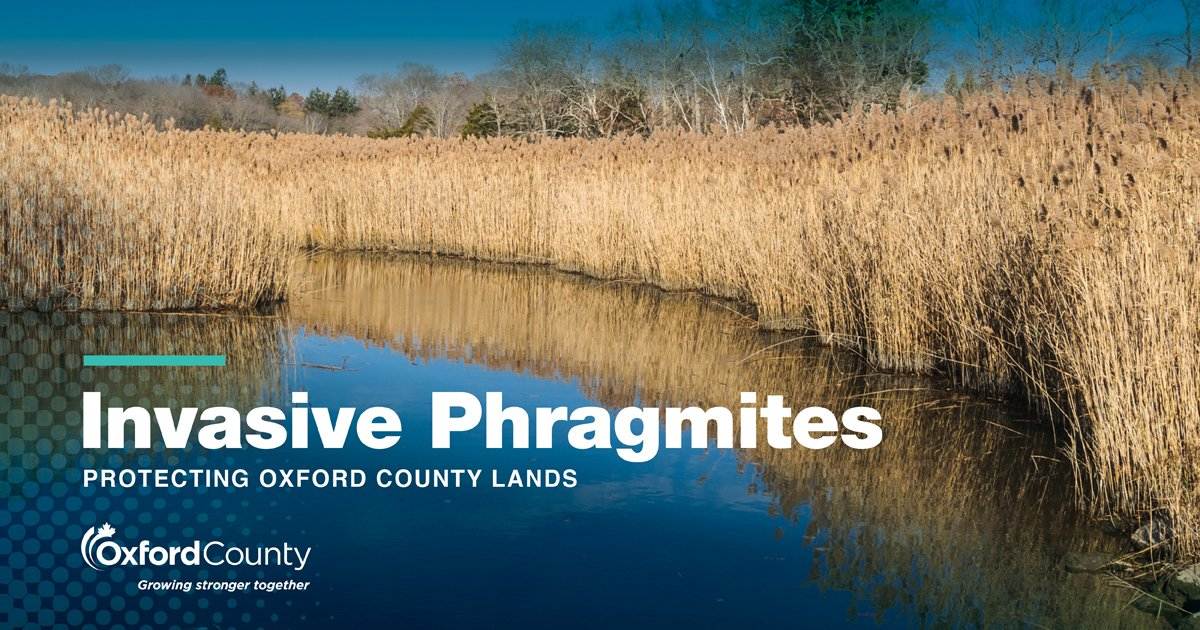Phragmites
What is phragmites?
Invasive phragmities (Phragmites australis australis), a European common reed, is a tall, perennial grass that is invading wetlands, roadside ditches and agricultural lands across Oxford County. Invasive phragmites (pronounced “frag-my-teez”) differs from its native counterpart (Phragmites australis americanus) by growing in extremely dense stands crowding out other species.
Invasive phragmites is very aggressive and will out-compete other native species for water and nutrients. They spread rapidly through seed dispersal and have an intricate system of specialized roots that readily grow into new plants. It is very difficult to completely eradicate invasive phragmites once it has been established.
Our table below indicates the differences between the invasive and native species.
| Description | Invasive phragmites | Native phragmites |
|---|---|---|
|
Latin name |
Phragmites australis subsp. australis |
Phragmites australis subsp. americanus |
|
Look |
|
|
|
Growth |
|
|
|
Density |
|
|
|
Height |
|
|
|
Common locations |
|
|
|
Leaf sheaths |
|
|
|
Stems |
|
|
- Crowds out native vegetation resulting in lower plant diversity
- Provides poor habitat and food for local wildlife
- Growth can impact local water levels and drainage infrastructure
- Increase fire risk as stands are composed of dry dead stalks
- Causes increased risk to road safety due to reduced sightlines
- Interferes with agricultural crop growth
- Do not purposely plant it.
Invasive phragmites is available at garden and horticultural centers. Learn to identify the difference between invasive and native species or select other native grasses for gardening. - Avoid the spread of seeds to new sites.
When leaving an area containing phragmites, brush off clothing and clean equipment. - Do not compost invasive phragmites.
The seeds and rhizomes (root system) can survive and start growing in compost. Cut plants can be left in place to decompose.
Methods used to control phragmites vary based on specific site characteristics. A combination of a non-chemical method (mowing or cutting) followed by a specific herbicide spray application applied by licensed applicators is one of the most effective ways to control phragmites. However, herbicide application may be prohibited in areas close to water and best management practice guidelines must be followed. Spot herbicide application over a 3-5 year period may be required to completely eliminate phragmites growth in targeted areas.
Control methods that don't work
- Cutting without use of hebicides
- Cutting or treating only some of the phragrmites grouping
- Cutting the plants afer a sead head develops
- Using a lower concentration of herbicide, applying at the wrong time, or not under proper weather conditions
- Cutting before or too soon after treatments
Control methods that do work
Please visit the Government of Ontario website for additional information on best management practices for phragmites.
Oxford County is working with stakeholders to develop a long-term strategy to tackle invasive phragmites. You may see County employees and County Contractors along roadways cutting and spraying the weed, starting in May-June, 2019
There may be opportunities for residents to partner with the County and participate in the Phragmites control plan. If you think you have invasive phragmites on your property and would like more information please contact Oxford County Public Works at 519-539-9800 or publicworks@oxfordcounty.ca.

